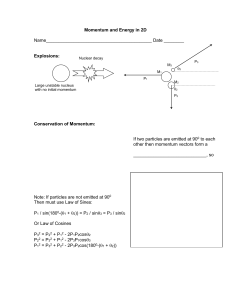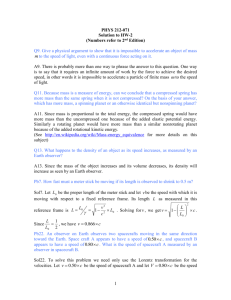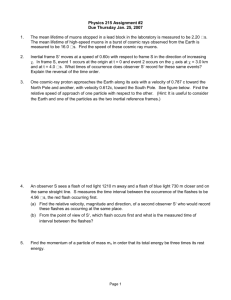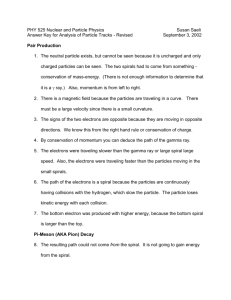KEY
advertisement
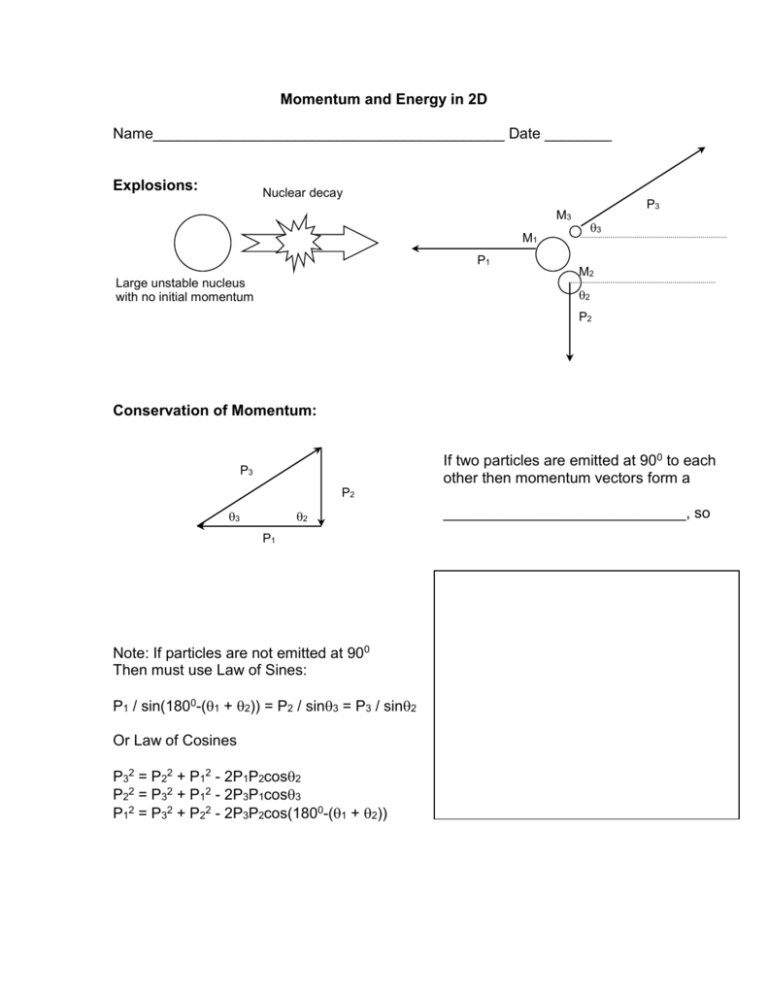
Momentum and Energy in 2D Name__________________________________________ Date ________ Explosions: Nuclear decay P3 M3 3 M1 P1 Large unstable nucleus with no initial momentum M2 2 P2 Conservation of Momentum: If two particles are emitted at 900 to each other then momentum vectors form a P3 P2 3 2 P1 Note: If particles are not emitted at 900 Then must use Law of Sines: P1 / sin(1800-(1 + 2)) = P2 / sin3 = P3 / sin2 Or Law of Cosines P32 = P22 + P12 - 2P1P2cos2 P22 = P32 + P12 - 2P3P1cos3 P12 = P32 + P22 - 2P3P2cos(1800-(1 + 2)) _____________________________, so Collisions: V1f 1 M1 V1i M2 2 V2f Conservation of Momentum: P1f P2f 1 2 P1i If the collision is elastic, the target particle is initially stationary and the masses of the colliding particles are the same, as in the game of pool: m1 = m2 = m 1/2m1v1i2 = 1/2m1v1f2 + 1/2m2v2f2 so, 1/2mv1i2 = 1/2mv1f2 + 1/2mv2f2 v1i2 = v1f2 + v2f2 Velocity vectors must form a _____________ _____________________________________ According to the ________________________ _____________________________________ Examples: An unstable nucleus of mass 17 x 10-27 kg, initially at rest, disintegrates into three particles. One of the particles, of mass 5.0 x 10-27 kg, moves along the positive yaxis with a speed of 6.0 x 106 m/s. Another particle of mass 8.4 x 10-27 kg, moves along the positive x-axis with a speed of 4.0 x 106 m/s. Determine the third particle’s speed and direction of motion. (Assume that mass is conserved) Write down what you know mnucl = 17 x 10-27 kg m1 = 5.0 x 10-27 kg m2 = 8.4 x 10-27 kg m3 = mnucl – (m1 + m2) = 17 x 10-27 kg – (5.0 x 10-27 kg + 8.4 x 10-27 kg) = 3.6 x 10-27 kg vnuci = 0 m/s v1 = 6.0 x 106 m/s @ y-axis v2 = 4.0 x 106 m/s @ x-axis v3 = ? Draw a vector diagram of the momentum P2 3 P1 P3 Solve for the momentum of the third particle and then find its velocity Right angled triangle so use Pythagorean Theorem P12 + P22 = P32 therefore: (P12 + P22) = P3 ((m1v1)2 + (m2v2)2) = P3 ((5.0 x 10 –27 kg)(6.0x106m/s))2 + (8.4 x 10-27kg)(4.0 x 106 m/s))2 = P3 (2.0 x 10-39 kg2m2/s2) = 4.50 x 10-20 kgm/s = P3 v3 = P3 / m3 = 4.50 x 10-20 kgm/s / 3.6 x 10-27 kg = 12.5 x 106 m/s Use trig to determine the angle relative to the positive x-direction (going counter clockwise) 3 = tan-1 (P1 / P2 ) = tan-1 (m1v1 / m2v2) = tan-1 ((5.0 x 10 –27 kg)(6.0x106m/s) / (8.4 x 10-27kg)(4.0 x 106 m/s)) = tan-1 (3 x 10-20 kgm/s / 3.36 x 10-20 kg/m/s) = 41.760 Therefore: = 1800 + 3 = 1800 + 41.760 = 221.80 A particle with a speed v1 = 2.64 x 106 m/s makes a glancing elastic collision with another particle that is at rest. Both particles have the same mass. After the collision the struck particle moves off at 100 to v1. What is the speed of each particle after the collision and what angle is the incident particle scattered at? Write down what you know v1 = 2.64 x 106 m/s v2 = 0 m/s m1 = m2 = m 2 = 100 v1f = ? v2f = ? Draw a vector diagram of the situation (note: masses are the same so can use velocity vectors rather than momentum) v1f v2f 1 2 v1 Use trig to determine the speed of each particle after the collision v1f = v1sin2 = (2.64 x 106 m/s) sin100 = 4.58 x 105 m/s v2f = v1cos2 = (2.64 x 106 m/s) cos100 = 2.6 x 106 m/s Determine the scattering angle of the incident particle using geometry 1 = 900 - 2 = 900 – 100 = 800 wrt the incident particle direction
